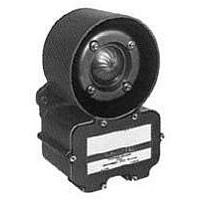MM2TC TELEX COMMUNICATIONS, MM2TC Datasheet - Page 4

MM2TC
Manufacturer Part Number
MM2TC
Description
25W Submergence-Proof Speaker
Manufacturer
TELEX COMMUNICATIONS
Datasheet
1.MM2TC.pdf
(4 pages)
Specifications of MM2TC
Body Material
Diecast Aluminum
DESIGNING FOR INTELLIGIBILITY AND ADEQUATE SPL
The Basic Idea
The following material explains these concepts in more detail and illustrates
two design approaches
What is Reverberation?
after the original sound has ceased Reverberation may also be considered
as aseries of multiple echoes so closely spaced in time that they merge into
a single continuous sound These echoes decrease in level with successive
expected as distance from the speaker is increased from the one-meter
(3 28-foot) measuring distance typically used in SPL specifications.
Wheresound is reflectedfrom wallsand other surfaces, thereisapoint beyond
which the "reverberant field" dominates and the sound pressure level is
alone
The reverberant field will begin todominatetypicallyatdistancesof 10to30
feet This distance is greatest for the least reverberant rooms and speakers
the backof the room that speech will probably be unintelligible
Many sound systems would have better performance
principles are kept in mind Speakers with the appropriatecoverage patterns
should bechosen, aimed and powered to achievea uniform direct field in the
highly absorbtive audience, with no sound aimed at the reflective wall and ceil-
ing surfaces Where multiple speakers are required in order to achieve a
uniformdirect field, their coverage patterns should beonlyslightly overlapped,
so that each section of the audience is covered by a single speaker To the
extent this ideal is achieved reverberation is minimized and intelligibility is
maximized
Reverberation is the persistence of sound within an enclosure, such asa room,
reflections, and eventually are completely absorbed by the room
Non-Reverberant Environments
An open, outdoor space is considered to be a non-reverberant environment,
as virtually all sound escapes the area without reflection.
Variations in Level Due to Distance for Non-Reverberant Environments
In non-reverberant environments, such as outdoors, sound pressure level will
be reduced by half (6 dB) every time the distance form thespeaker is doubled
(this is called the inverse-square law). Figure A shows the dB losses to be
Reverberant Environments
higher and more constant than predicted by using the inverse-square law
Variations in Level Due to Distance for Reverberant Environments
with narrow beamwidth angles The frequency and beamwidth speckations
provided by the datasheet are still required to obtain satisfactory distribution
of the direct sound (or direct field) from the loudspeaker(s) which still follows
the inverse square law It is the direct signal that contributes to speech
intelligibility This is why the sound system designer should seek a uniform
directfield, with aslittle reverberantfieldas possible For example, consider
a single speaker with awide beamwidth angle used to cover a long, narrow
reverberant room The direct field will be so far below the reverberant field at
Calculating Variations in Level Due to Changes in Electrical Power
Each time the power delivered to the speaker is reduced by one-half, a level
dropof3dBoccurs Thenomographof FigureBshowsthethechangein dB
to be expected as the power varies from the one-watt input typically used in
SPL specifications
Power Handling
The power rating of a speaker must be known to determine whethera design
is capable of meeting the sound pressure level requirements of the system
The power rating combined with the sensitivity will enable a system designer
to calculate the maximum sound pressure level attainable at a given distance
Part Number 531291-923
US 42-02-0261 17
Litho in U.S.A
BASIC GUIDELINES FOR THE USE OF HORNS AND DRIVERS WITHIN A SOUND SYSTEM.
if
the following basic
The average power that must be delivered to the speaker@) to achieve the
tion with power. Enough additional power must be available to reproduce
Thisdifference between the peakand averagecapability of a sound system,
the average (1 0 dB).
The better sound systemsare designed for peaks that are 10 dB above the
than using the basic horizontal and vertical beamwidth angles Environments
which have excessive reverberation or high ambient noise levels make
to utilizeeven thesimpler systems are not attractivetosomesound systems
found in the University Sound Guide
Powering to Achieve Both Average and Peak SPL
desired average SPL can be determined from the previously presented
material on speaker sensitivity, level variation with distance and level varia-
without distortion the short-term peaks that exist in voice and music program.
when expressed in dB, is often called "peak-to-average ratio," "crest factor"
or "headroom." The peaks can be large, as noted earlier: at least
average, although 6 dB of headroom is sufficient for most general-purpose
voice paging systems The 1 0-dB peaks require amplifier power ten times that
requiredfor theaveragesound levels The 6-dB peaks require fourtimesthe
power.
Utilizing Speaker Beamwidth Information for Maximum Intelligibility
Knowing the beamwidth angle of a loudspeaker can aid in providing a unlorm
direct field in the listening area After selecting a desired speaker location, the
beamwidth angle needed to adequately cover the listeners without spilling
over to the walls or ceilings must be determined Once these angles are
known the correct speaker can be found by using catalog specifications
Using Easy-VAMP
In some circumstances d is desirable to use an approach that is more detailed
especially difficult to achieve the desired SPL and intelligibility
In recent years a number of computer based techniques have been
developed to help sound system designers Some of the more complex
systems use personal computers with relatively sophisticated graphics
Simpler systems, such as Electro Voice s VAMP
Program) utilize clear overlays and require programmable scientific
calculators However, the hardwareisoftware and training investment required
designers Because of this University Sound has developed a special
adaptation of VAMP, called Easy VAMP
aid without the complexity and cost of the VAMP programs
More information on both the Easy VAMP
DISTANCE FROM
SPEAKE:IH;
Level Variation
With Distance
FIGURE A
: : $ a
lmm
M
4
TM
CHANGE IN
M
and Floor-Plan Isobars
(dB)
TM
TM
which providesa similar design
and floor plan isobars can be
Level Variation
TM
With Power
FIGURE B
(Very Accurate Mapping
3+m
M
f 2 5
10
times
it





